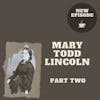Mary Todd Lincoln: Part Two

Join me this week as I wrap up the life of Mary Todd Lincoln. In this episode, I review her time as First Lady, her friendship with dressmaker Elizabeth Keckly, and why she was committed to an asylum.
SOURCES:
“Biography of Mary Todd Lincoln.” Mary Todd Lincoln House. (LINK)
Clinton, Catherine. Mrs. Lincoln: A Life. United States: HarperCollins, 2009.
“Family: Mary Todd Lincoln.” Mr. Lincoln’s White House. The Lehrman Institute. (LINK)
“LIfe Story: Mary Todd Lincoln (1818-1882).” Women and the American Story. New York Historical Society Museum & Library. (LINK)
Mann, Lina. “From Slavery to the White House: The Extraordinary Life of Elizabeth Keckly.” White House Historical Association. (LINK)
Welcome to Civics and Coffee. My name is Alycia and I am a self-professed history nerd. Each week, I am going to chat about a topic on U.S history and give you both the highlights and occasionally break down some of the complexities in history; and share stories you may not remember learning in high school. All in the time it takes to enjoy a cup of coffee.
INTRO MUSIC
Hey everyone, welcome back.
Last week, I started reviewing the life and hardships of Mary Todd Lincoln, wife to 16th President Abraham Lincoln. The first First Lady to be widowed due to an assassin’s bullet, I thought it was important to spend more than an episode reviewing her life and the tragedies that permanently altered her worldview.
While Lincoln is often remembered as the quirky First Lady who held seances in her bedroom, the life and legacy of Mary Todd Lincoln is much more nuanced.
So this week, I am wrapping up the life of Mary Lincoln. How did she navigate the Civil War? How did she react to the death of her husband? And why was she committed?
Grab your cup of coffee, peeps. Let’s do this.
Before I begin, I do want to provide a bit of a warning to my listeners out there. In this episode, I discuss the friendship between Mary and her dressmaker Elizabeth Keckley. Part of that requires giving a little bit of Keckley’s origin story and includes themes of sexual violence. I will give another warning as we get closer, but if you would feel better skipping this week, I understand.
When we left off, the Lincolns had just moved to Washington, D.C. to assume their new roles. The president had to come to terms with how to navigate his office while facing the most significant challenge the country faced to date. Mary also had her work cut out for her. As First Lady, she would be responsible for the social calendar and hosting D.C. society. However, these were not normal times. Mary likely struggled with understanding what exactly the protocol was for hosting social events while the nation was at war with itself.
Mary threw herself into renovating the White House, overspending her allotted stipend from Congress. Her overspending, something that would become a bit of a hallmark for the First Lady, upset her husband who, instead of requesting additional funding from Congress, made a commitment to try to pay for the overspending personally.
Making matters worse was the fact that Mary and her husband were written off as western, unsophisticated individuals who were somehow unworthy of the office. Despite growing up in an upper class southern family and receiving one of the finest educations available, D.C. society snubbed their noses at the First Lady, refusing to engage with her in any meaningful way. Media coverage of Mary was also pretty unfavorable, including an unsubstantiated story that she was having an affair. Given her southern roots, the press made no qualms about questioning the First Lady’s loyalty to the Union, insinuating she could be a Confederate spy.
Despite the criticisms, Mary and her husband sought to use the White House to their advantage. From historian Catherine Clinton quote, “the Lincoln’s were the first residents of the White House to see the potential of making their home a national stage. They introduced the practice of bringing artists and performers into the Executive Mansion for social occasions, as part of their White House entertaining,” end quote. It is likely because of this that Mary felt her renovations were so important and were worth going over budget.
As her husband spent endless hours trying to save the country, Mary’s sense of loneliness only compounded. Basically ostracized from D.C. society, Mary had few friends on which she could call upon to help her navigate her new reality. This led to the First Lady striking up a friendship with dressmaker Elizabeth Keckley. And here my friends is where I will dive into some triggering bits of history. Feel free to skip ahead a few seconds if needed.
Keckley was born in Virginia in 1818 to an enslaved woman, and was likely the result of rape between Keckley’s mother, Agnes Hobbs, and plantation owner Armistead Burwell. Elizabeth learned her trade through her mother, who sewed as part of her duties as an enslaved woman assigned to domestic work. As a young woman, Keckley was hired out to work for Burwell’s son Robert in North Carolina. Repeating her mother’s history, Elizabeth was forced to endure sexual humiliation, suffering repeated rapes by a local store owner, which also resulted in the birth of her only son, George. After the death of Burwell, Keckly, her mother, and her son George became the property of Burwell’s widow and her son-in-law, Hugh Garland. Keckley was eventually reunited with her mother where the two would be forced to relocate to St. Louis as the result of their new quote unquote owner’s hopes of finding prosperity in a new location.
When prosperity did not come, Garland hoped to hire out Keckly’s mother, however Elizabeth intervened, asking that she use her services as a seamstress to make money for the family and save her mother from performing work in her advanced age. Eventually, Elizabeth secured an agreement to purchase her and her son’s freedom and moved to Washington, D.C. in 1860. It was during her time in D.C. that fate brought her into the orbit of Mary Lincoln, who hired Keckly to be her seamstress.
Keckly’s story is fascinating in of itself - let me know if you would like an episode dedicated to her and her experiences once this goes live.
Without friends of similar station and experience, Mary and Keckly grew incredibly close and the First Lady often confided in Keckly about her struggles and concerns. And she likely relied heavily upon Keckly after the death of her son William, often referred to as Willie, passed away from typhoid fever on February 20th, 1862. Mary, who was in the middle of planning a ball at the White House, originally wanted to cancel the event given the state of her son. However, doctors originally believed no harm would come to Willie, telling the Lincoln’s their son was in no immediate danger.
Losing another son prompted Mary to retreat from public view and give up on her hostess duties. A woman who was prone to bouts of depression likely saw no end to the immense grief of losing another child, especially when considering her concerns ahead of Willie’s death. Her depression got so bad that her husband began to worry about her ability to recover and resume normal duties. Lincoln apparently showed his wife an asylum and warned she could become a resident if she could not get back to a sense of normalcy.
Lincoln, who had the entire country’s future on his shoulders, had plenty to distract him and help him compartmentalize the grief he experienced over losing his son. Mary had no such distraction. So, instead of wallowing in her grief permanently, the First Lady resumed her social schedule about two months after Willie’s passing. Perhaps as a way to fill up time, or a way to distract herself from her tremendous grief and guilt, Mary began a ritual of visiting injured soldiers. Mary later claimed sitting with the men helped her process her grief. Throughout the war, Mary would spend a significant amount of time attending to soldiers and trying to support them as best she could. Again from historian Catherine Clinton, quote: “by January 1863, Mary’s hospital work had become her most zealous campaign - next to protecting her husband from his enemies,” end quote.
It was after Willie’s death that Mary also started getting into spirit circles. Described as quote “gatherings organized by mediums who practiced spiritualism” end quote, Mary joined thousands of other Americans in trying to find ways to communicate with lost loved ones. Spirit circles and spiritualism, or the belief one could communicate with the dead, significantly increased in popularity during the Civil War, likely as a result of the sheer volume of individuals who lost loved ones.
Another way Mary hoped to fill the hole created by her son’s death was through shopping. Throughout her life, Mary struggled with bouts of overspending. I am not a psychologist by any stretch of the imagination, but the excessive shopping sprees - spending money on frivolous items she knew she did not need nor could afford, feels like what one might experience during a manic episode, making me think perhaps Mary suffered from either manic depression or bipolar disorder.
In July of 1863, Mary was seriously injured while trying to enjoy a carriage ride with her husband. A screw had become dislodged in the carriage, causing the seat to become unstable. Riding alone in the carriage alongside her husband who decided to ride on horseback, Mary was thrown from the carriage and hit her head on a rock, creating a deep gash requiring medical attention. Later inspection of the carriage revealed it was tampered with, further increasing concerns about the President’s safety.
When Mary’s little sister, Emilie Todd Helm, lost her confederate soldier husband in battle, the First Lady thought nothing of inviting her to the White House to grieve. This decision was supported by her husband, who believed the visit with her sister would prove helpful for Mary in processing her grief. The two sisters seemed to soothe each other, and the President noticed an immediate improvement in his wife. However, hosting the wife of a confederate sympathizer in the White House proved scandalous. It did not matter to outsiders that the woman in question was the First Lady’s sister. All anyone focused on was the fact that the spouse of someone who had taken up arms against the Union was now a welcomed visitor in the Executive Mansion. For his part, Lincoln remained committed to his choices, telling one detractor quote: “my wife and I are in the habit of choosing our own guests. We do not need from our friends either advice or assistance in the matter” end quote.
Mary had something else to fill her time when her husband decided to run for re-election. Despite being a very well educated woman, Mary made some arguably questionable decisions in her pursuit to ensure her husband’s victory, including engaging with some pretty shady political characters in New York. Her plan was to try to convince these powerful men that they could expect some form of political reward if they helped her husband win the presidency. Of course, the president himself appears to have been oblivious to these overtures and the plan backfired miserably.
Mary was also worried about what faced her should her husband fail to win re-election. Having spent another significant sum on shopping in the aftermath of her son’s death, Mary was worried how they’d come out from under the weight of their debt if her husband did not win. In her time in the White House, the First lady had accumulated debt totaling her husband’s annual $25,000 salary - a sum he could not likely command if forced to return to private life. Luckily for her debts, Lincoln won re-election.
No doubt happy for her husband’s political victory, Mary had something else to worry about: her eldest son, Robert, had decided to join the Union army. The debate of whether to allow Robert’s enlistment had been a sore spot in Mary and Abraham’s marriage, with Mary being steadfast in her resolve that her son would never be put in harm’s way. For Mary, the idea that she could lose a third son was a bridge too far. Yes, she supported the Union, but in her mind she had already lost one son to the cause - she was not prepared to lose another. For Abraham, on the other hand, the fact that his son was not in uniform made him seem weak or uncommitted to the cause. Several members of Lincoln’s inner circle made comments about Robert’s lack of service. And, of course, Robert himself wanted to be of use. So, in the early months of 1865, Mary relented and Robert worked as a member of Ulysess S. Grant’s staff.
When the Confederate army finally surrendered in April of 1865, the Lincolns likely breathed a huge sigh of relief. Finally, the president would get a chance to run the country. He would not be focused on war preparations or military strategy. Instead, he could focus on rebuilding the country and implementing new ideas. Unfortunately, this seemingly bright future was cut all too short. Just a few days after hearing of the southern surrender, the President and First Lady decided to take in a show. Together, the couple journeyed to Ford’s Theater on April 14th to watch the play Our American Cousin. And it was while sitting with her husband that shortly after 10pm, Mary Lincoln witnessed the horrific attack on her husband as he was shot in the head by John Wilkes Booth.
The president was quickly escorted across the street and placed diagonally across a bed while doctors tried to make him comfortable. Mary, understandably in a state of shock and horrified at what she just witnessed, was overcome with grief. She would break down into uncontrollable sobs, hoping and praying for her husband’s recovery. The men in the room decided it was in her best interest to be kept ignorant of her husband’s condition, as medical personnel and attendants frequently changed the bed linen to hide the amount of blood emanating from Lincoln. Her outbursts proved to be too much for Secretary of War Edwin Stanton, who ordered the First Lady out of the room and barred her from returning, denying Mary the right of attending to her husband in his last moments. In fact, upon hearing of her husband’s passing, the First Lady was beside herself, demanding to know why she was excluded.
Losing her husband just when things seemed to be returning to normal put Mary into another depressive tailspin. She was unable to attend services for her husband, leaving her son Robert to represent the family as the nation mourned the loss of the President. Lincoln’s Vice President, Andrew Johnson, allowed Mary to stay in the White House long enough to pack up her things, but the First Lady failed to move with the speed others expected. Johnson grew impatient with Mary, believing she had overstayed her welcome. However, despite losing her husband in the middle of April, Mary was on her way by May, headed toward Chicago to be close to her husband’s burial site in Springfield.
Likely running on a bit of autopilot, the First Lady later disclosed to a friend quote, “there are hours of each day, that I cannot bring myself to believe, that it has not all been some hideous dream, and in my bewildered state, I sometimes feel that my darling husband, must and will return to his sorrowing, loved ones,” end quote. The first First Lady to lose her husband to an assassin’s bullet, Mary believed she would be greatly cared for by her country. After all, her husband paid the ultimate sacrifice in defense of the nation. The reality did not align with her expectations.
Instead of caring for the bereaved First Lady, many ostracized her. She was a woman who had rubbed people the wrong way for a long time and they were more than happy to leave her behind. However, as a woman, Mary relied on her husband’s earnings to provide for her. Lincoln left a decent estate, valued at $85,000, but Mary would only see a third of that as the rest was to be divided between their two remaining sons, Robert and Tad. As mentioned, Mary had wracked up quite an extensive debt and was worried about how she would pay it all off without an adequate source of income. Unfortunately, upon hearing the value of the late president’s estate, very few had sympathy for the First Lady.
In the aftermath of her husband’s death, Mary continued to make questionable decisions and frequently found herself on the wrong end of the news story. Despondent over how she was being treated, the First Lady decided to spend some time overseas, sailing to Germany in October 1868. She was finally granted a pension in 1870, totalling $3,000 a year, just shy of the $5,000 she originally asked for. However, Mary understood that every dollar counted and she gladly accepted the funds.
Death was not yet not with Mary, who lost her youngest son, Tad, on July 15th, 1871. Just 18 years old, his cause of death was tuberculosis, the same ailment that had claimed Edward in 1850. Mary’s actions grew more and more erratic, so much so that her eldest son Robert decided to have her committed to the Bellevue Sanatorium on May 20th, 1875 - just past the tenth anniversary of her husband’s death. For Mary, the commitment was the ultimate betrayal and caused a significant rift between her and Robert. Her confinement lasted just a few months before Mary was granted temporary release to her sister’s care in September. The financial conservatorship and insanity diagnosis, however, remained in place for a year.
Mary spent her remaining years as a bit of recluse. She continued to participate in spirit circles, dealing with questionable figures who promised the ability to commune with her dead sons and husband. She successfully lobbied Congress for an increase in her pension once President Garfield’s widow was awarded $5,000, and also received a back payment of $15,000. She passed away on July 16th, 1882 at the age of 63.
Mary Lincoln was a woman who so desperately wanted to be accepted. She was unapologetically ambitious and believed in the possibilities of her husband, but she was someone who just did not conform to others expectations and, despite losing her husband in service of her country, could never get in the public’s good graces for long. A woman who likely suffered from mental illness before it was widely studied and treated, I think it is perhaps a testament to her fortitude that Mary Todd Lincoln survived all the tragedy that befell her family as well as she did.
Here is to hoping the future treats Mary Lincoln with a bit more grace.
Thanks, peeps. I will see you next week.
Thanks for tuning and I hope you enjoyed this episode of Civics & Coffee. If you want to hear more small snippets from american history, be sure to subscribe wherever you get your podcasts. Thanks for listening and I look forward to our next cup of coffee together.
OUTRO MUSIC
Listener Favorites
Not sure where to begin? Take a listen to some fan favorites.

























